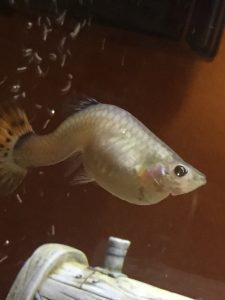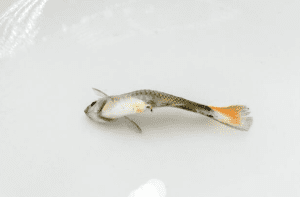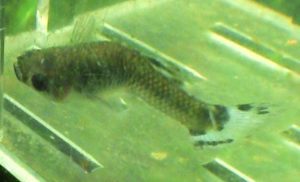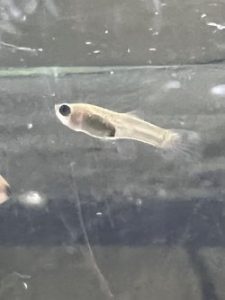The guppy, a beloved aquatic creature among enthusiasts of aquariums, exhibits a strikingly vibrant and lively demeanor, rendering it an easy-to-maintain species.
However, this organism, like any other living entity, is susceptible to myriad afflictions of health. Among the catalogue of afflictions that the guppy is known to experience, bent spine represents a ubiquitous and persistent concern.
This condition, characterized by the lateral curvature of the fish’s spinal column, results in an anomalous body shape that can prove distressing and painful for the guppy, ultimately impeding its mobility and overall well-being.
In the present discourse, we shall expound upon the intricacies of guppy scoliosis, ranging from its detection, diagnosis, and management, to its prevention.
Through the assimilation of the knowledge we impart, you will emerge enlightened on the measures necessary to ensure the optimal care of your guppies, safeguarding their wellness and contentment.
What is guppy scoliosis?
Guppy scoliosis is a condition that affects the spine of guppies, a popular freshwater aquarium fish.
This condition causes a deformity in the shape of the spine, leading to a curvature that can be seen from the outside of the fish.
Typically, the curvature is in a lateral direction, meaning the spine bends either to the left or right side of the fish. In some cases, the curvature can be severe, causing the tail or head of the fish to twist or curve abnormally as well.
While the exact cause of guppy’s bent spine is unknown, it is believed to be genetic.
This means that some guppies may be more prone to developing the condition than others.
It is important to note that guppy scoliosis is not contagious and cannot be spread between fish, so there is no need to isolate affected fish from healthy ones.
Diagnosing guppy scoliosis is relatively straightforward. The curvature of the spine is usually visible from the outside of the fish, and a veterinarian or experienced fish keeper can confirm the diagnosis through physical examination.
While there is no cure for guppy bent spine, there are some treatment options available.
Mild cases may not require any treatment at all, while more severe cases may require euthanasia to prevent the fish from suffering.
In some cases, surgery may be an option to correct the curvature of the spine, but this is a risky and expensive procedure that is not always successful.
Preventing guppy bent spine is the best approach. This can be done by avoiding inbreeding and maintaining a healthy breeding environment.
Providing a balanced diet, clean water, and proper tank conditions can also help to prevent the development of guppy scoliosis.
Regular check-ups by a veterinarian or experienced fish keeper can also help to catch the condition early and prevent it from worsening.
Causes of Scoliosis in Guppies
Guppy bent spine is a condition that affects the spine of guppies, causing a curvature in the backbone. The exact cause of this condition is not completely understood, but there are several factors that are believed to contribute to the development of guppy scoliosis.
One of the main causes is genetics. Guppies that are bred from parents with scoliosis are more likely to develop the condition themselves. This is because it’s is a hereditary condition, meaning it can be passed down from generation to generation.
Another possible cause of guppy scoliosis is poor water quality. Guppies that are kept in water that is too acidic or has high levels of ammonia or nitrate can develop bent spine as a result of the stress that these conditions cause.
In some cases, guppy scoliosis can also be caused by traumatic injury to the spine. This can occur if the fish is handled roughly or if it is attacked by another fish in the aquarium.
It’s important to note that while guppy bent spine is more common in certain breeds of guppies, such as fancy guppies, it can occur in any type of guppy.
Understanding the causes of guppy scoliosis is the first step in preventing and treating this condition.
By providing your guppies with a healthy environment and being aware of the risks associated with breeding, you can help to reduce the likelihood of guppy scoliosis occurring in your aquarium.
Symptoms of Scoliosis in Guppies
Guppy bent spine is a condition that affects many breeds of guppies.
It is a deformation of the fish’s spine that causes curvature and can lead to difficulty swimming and eventually death.
Therefore, it is important for guppy owners to be aware of the common symptoms of this condition.
One of the most noticeable symptoms is a bent or curved spine.
This can cause the fish to have an abnormal swimming pattern or to struggle to swim at all.
Another symptom is the fish’s body appearing to be twisted or bent.
In severe cases, the guppy’s head may even be angled in a different direction than its body.
It’s also important to keep an eye out for any abnormal behavior such as the fish isolating itself from other fish or not eating. Additionally, if you notice that the guppy is having trouble staying upright or is floating on its side, this could be a sign of guppy scoliosis.
If you notice any of these symptoms, it’s important to take action immediately to ensure the best chance of treatment and recovery for your guppy.
Regular monitoring of your fish’s behavior and appearance can help catch any signs of guppy scoliosis early and prevent further damage.
Diagnosing Scoliosis in Guppies
Diagnosing guppy bent spine can be quite challenging, especially for the novice fish keeper.
However, there are a few signs to look out for that can help you identify if your guppy is suffering from scoliosis.
Observation and Visual Examination
One of the most noticeable symptoms is a curved spine, which can be seen when you view the fish from above or from the side. This curved spine can be either to the left or right side and is usually accompanied by a bent or twisted tail.
Use of X-rays
X-rays can also be used to identify scoliosis in guppies. X-rays can offer a more thorough image of the spine and aid in determining the degree of curvature. This is something your veterinarian or a fish specialist may assist you with.
Lethargic swimming
Another sign to look out for is the fish’s swimming behavior.
Fish with bent spine tend to have difficulty swimming and may appear to be struggling or swimming awkwardly.
Loss of appetite
It’s also important to observe the fish’s behavior and feeding habits.
Fish suffering from scoliosis may become lethargic and lose their appetite, which can lead to malnourishment and further health complications.
If you suspect that your guppy is suffering from scoliosis, it’s best to consult a veterinarian or a fish specialist who can confirm the diagnosis and provide you with the appropriate treatment plan.
Early diagnosis and treatment can greatly improve the chances of recovery for your guppy.
<iframe width=”560″ height=”315″ src=”https://www.youtube.com/embed/Dv6YNMepKW0″ title=”YouTube video player” frameborder=”0″ allow=”accelerometer; autoplay; clipboard-write; encrypted-media; gyroscope; picture-in-picture; web-share” allowfullscreen></iframe>
<iframe width=”560″ height=”315″ src=”https://www.youtube.com/embed/QN-s33ddhSQ” title=”YouTube video player” frameborder=”0″ allow=”accelerometer; autoplay; clipboard-write; encrypted-media; gyroscope; picture-in-picture; web-share” allowfullscreen></iframe>
Medication options for guppy scoliosis
When it comes to medication options for guppy bent spine, there are a few options available to fish keepers.
However, it’s important to note that medication alone may not be enough to completely treat the condition.
One medication option is the use of antibiotics to treat any potential bacterial infections that may have contributed to the development of scoliosis in the fish. This can help to reduce any inflammation and help the fish to heal.
Another medication option is the use of anti-parasitic medication. Parasites can be a contributing factor to the development of bent spine in guppies and treating these parasites can help to reduce the progression of the condition.
It’s important to note that medication should never be used as a standalone treatment for guppy scoliosis.
A combination of medication, proper diet, and clean water conditions are necessary to help treat and prevent this condition in your guppies.
How to Treat Guppy Bent Spine Scoliosis
Guppy scoliosis is a common condition that affects many guppy fish in aquariums. If left untreated, it can cause a lot of discomfort and even lead to death. Fortunately, treating guppy scoliosis is possible, and there are several methods that can be used to help your fish recover.
Changing Water Parameters
Scoliosis in guppies can be exacerbated by poor water quality. As a result, maintaining appropriate water parameters such as pH, temperature, and ammonia levels is critical. This can be accomplished by making regular water changes, utilizing a high-quality filter, and checking the water on a regular basis.
Creating a Healthy Tank Atmosphere
By providing a healthy environment for your fish and adopting preventative actions, you can help guarantee that your guppies live happy and healthy lives.
Guppies with bent spine may find it difficult to swim or move around in the tank.
As a result, it is critical to establish a comfortable and secure atmosphere for them. Y
ou can accomplish this by including plants, caves, and other decorations that give hiding spaces and resting areas.
Surgical Treatment
In extreme situations, surgery may be necessary to rectify the spine’s curvature. This is a sensitive treatment that should only be performed by a skilled veterinarian.
Scoliosis surgery in guppies is dangerous and can result in complications like as infections, bleeding, and anesthesia-related issues. As a result, it should only be done by a qualified and experienced veterinarian or fish specialist.
Surgery can assist guppies with scoliosis rectify their spine curvature and enhance their general health and enjoyment of life. The success rate of surgery, however, varies depending on the severity of the illness.
Diet and Nutrition
One of the most effective ways to treat guppy bent spine is by providing your fish with a nutritious and balanced diet. A healthy diet can help improve the overall health of your fish, which can in turn help treat scoliosis.
Overall, treating guppy scoliosis requires a combination of proper diet, medication, correct enviromental conditions, and sometimes surgery.
Proper care for guppies with scoliosis
Proper care for guppies with scoliosis is crucial to their overall health and well-being.
First and foremost, it’s important to diagnose scoliosis in your guppy early on, as early intervention can greatly improve the prognosis for the fish.
Once diagnosed, it’s important to provide your guppy with a comfortable and stress-free environment.
You should ensure that the water conditions are optimal, with a proper pH balance and adequate filtration. It’s also important to maintain a consistent temperature in the tank, as fluctuations can increase stress levels in your fish.
In terms of treatment, there are a few options available for guppies with scoliosis.
One option is to use a brace or support system to help straighten the fish’s spine. These can be purchased at most pet stores or online.
Another option is to provide physical therapy for the fish, which can include gentle exercises and stretches to help improve their mobility.
Prevention is also key when it comes to guppy scoliosis. To prevent this condition from occurring in the first place, it’s important to maintain a healthy and balanced diet for your fish, as well as providing them with adequate space to swim and exercise.
It’s also important to keep the tank clean and free from harmful bacteria or parasites that can cause stress and weaken the fish’s immune system.
By providing proper care and treatment for guppies with scoliosis, you can greatly improve their quality of life and ensure they live a happy and healthy life.
Breeding tips for guppies with scoliosis
Breeding guppies with scoliosis can be a challenging task, but it’s not impossible.
The goal of breeding guppies with scoliosis is to produce offspring with less severe or no deformity.
To increase the chances of producing healthy offspring, it’s important to select breeding pairs carefully.
Choose one guppy with scoliosis and one without to produce a batch of offspring.
This will increase the likelihood of producing offspring with less severe deformities.
It’s also essential to ensure that the breeding environment is optimal.
This includes maintaining water quality, temperature, and pH levels within the recommended range.
Additionally, make sure that the breeding pairs are well-fed and free from infections and diseases.
To prevent the spread of scoliosis in your guppy population, it’s crucial to cull any guppies with severe deformities. This might be a difficult decision, but it’s necessary to maintain the overall health and well-being of your guppy population.
Breeding guppies with scoliosis requires patience and careful planning.
Prevention of Scoliosis in Guppies
Preventing guppy scoliosis should be a top priority for any guppy owner. The good news is that there are several steps you can take to prevent this condition from occurring in your guppies.
Diet
Make sure you provide your guppies with a healthy and balanced diet. A diet that is high in vitamins and minerals can help to keep your guppies healthy and prevent scoliosis from developing.
Proper Tank Setup
Maintain a clean and healthy aquarium environment. Regularly clean the tank and change the water to prevent the buildup of harmful bacteria and toxins that can cause guppy scoliosis.
Preventing Overcrowding
Avoid overbreeding your guppies. Overbreeding can lead to weakened and deformed offspring, which are more susceptible to diseases and conditions like scoliosis.
Overcrowding can lead to poor water quality, stress, and an increased risk of infections, which can contribute to the development of scoliosis in guppies.
Therefore, it is essential to maintain a proper fish-to-water ratio and avoid overstocking the tank.
Choosing Healthy Guppies
Choose healthy and disease-free guppies to add to your aquarium. Quarantine any new guppies before introducing them to your tank to prevent the spread of diseases and infections.
By following these prevention tips, you can help to keep your guppies healthy and free from scoliosis. If you do suspect that your guppy has developed scoliosis, seek the advice of a veterinarian who specializes in aquatic animals.
Conclusion
In conclusion, guppy bent spine is a common condition in which the fish experiences a curved spine. While it may not necessarily be harmful to the fish, it can impact their ability to swim and breed, making it important to address the issue.
Diagnosis can be done through visual observation, but treatment may vary depending on the severity of the condition. Options include breeding for stronger genetics, medication, and aquarium adjustments to enhance the fish’s environment.
Prevention is key in avoiding guppy scoliosis altogether. This can be done by providing a clean and healthy environment, avoiding overfeeding, and selecting healthy breeding pairs.
It’s important to remember that prevention is always better than treatment. By taking proactive steps to maintain a healthy environment and breeding strong genetics, you can greatly reduce the likelihood of your guppies developing scoliosis.
With the right care and attention, guppies can live happy and healthy lives, free of the discomfort and limitations caused by scoliosis.
As a responsible fish owner, it’s crucial to understand and identify the symptoms of Guppy bent spine in your fish. We also discussed the treatment options available and the best ways to prevent this condition from occurring in the first place.
By following the tips outlined in this article, you can ensure that your guppies stay healthy, happy, and free from Guppy bent spine.
Thank you for reading and taking care of your finned friends!





